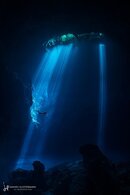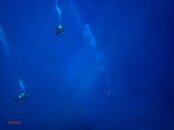RonFrank
Contributor
My buddy is sometimes a CF19. I prefer a live buddy, but my family does not dive, and we vacation together, so I am often with insta-buddies on vacation. One reason I love shallow reefs! Run into a problem you are 20' from the surface. I am rarely more than 15' from a buddy, maybe a bit farther on a shallow reef with good vis.
I've dove CO lakes where we almost had to hold hands as the vis was measured in inches. Visibility dictates how far you can be from a buddy. Current is also a big factor. We were in Coz with hundreds of feet of vis only to realize the current was so strong you may be unable to reach your buddy. We were at over 80' deep, so getting to your buddy was desirable. If you could signal your buddy fine, if not you're SOL. We realized we had to stay closer when the current was ripping. BTW, what a fantastic dive!
I bought a pony after that trip which I have never used, but better safe than sorry. I'm definitely a buddy diver, but realize that if you do not travel with a buddy a pony is a damn fine alternative.
I've dove CO lakes where we almost had to hold hands as the vis was measured in inches. Visibility dictates how far you can be from a buddy. Current is also a big factor. We were in Coz with hundreds of feet of vis only to realize the current was so strong you may be unable to reach your buddy. We were at over 80' deep, so getting to your buddy was desirable. If you could signal your buddy fine, if not you're SOL. We realized we had to stay closer when the current was ripping. BTW, what a fantastic dive!
I bought a pony after that trip which I have never used, but better safe than sorry. I'm definitely a buddy diver, but realize that if you do not travel with a buddy a pony is a damn fine alternative.





